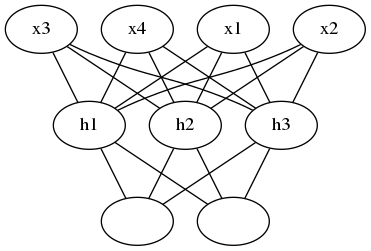Multi-Layer Perceptrons
Table of Contents
This is basically like the previous gradient-descent post but with more layers.
Set Up
Imports
From PyPi
from graphviz import Graph
import numpy
The Activation Function
def sigmoid(x):
"""
Calculate sigmoid
"""
return 1/(1 + numpy.exp(-x))
Defining Our Network
These variables will define our network size.
N_input = 4
N_hidden = 3
N_output = 2
Which produces a network like this.
graph = Graph(format="png")
# input layer
graph.node("a", "x1")
graph.node("b", "x2")
graph.node("c", "x3")
graph.node("d", "x4")
# hidden layer
graph.node("e", "h1")
graph.node("f", "h2")
graph.node("g", "h3")
# output layer
graph.node("h", "")
graph.node("i", "")
graph.edges(["ae", "af", "ag", "be", "bf", "bg", "ce", "cf", "cg", "de", "df", "dg"])
graph.edges(["eh", "ei", "fh", "fi", "gh", "gi"])
graph.render("graphs/network.dot")
graph

Next, set the random seed.
numpy.random.seed(42)
Some fake data to train on.
X = numpy.random.randn(4)
print(X.shape)
(4,)
Now initialize our weights.
weights_input_to_hidden = numpy.random.normal(0, scale=0.1, size=(N_input, N_hidden))
weights_hidden_to_output = numpy.random.normal(0, scale=0.1, size=(N_hidden, N_output))
print(weights_input_to_hidden.shape)
print(weights_hidden_to_output.shape)
(4, 3) (3, 2)
Forward Pass
This is one forward pass through our network.
hidden_layer_in = X.dot(weights_input_to_hidden)
hidden_layer_out = sigmoid(hidden_layer_in)
print('Hidden-layer Output:')
print(hidden_layer_out)
Hidden-layer Output: [0.5609517 0.4810582 0.44218495]
Now our output.
output_layer_in = hidden_layer_out.dot(weights_hidden_to_output)
output_layer_out = sigmoid(output_layer_in)
print('Output-layer Output:')
print(output_layer_out)
Output-layer Output: [0.49936449 0.46156347]